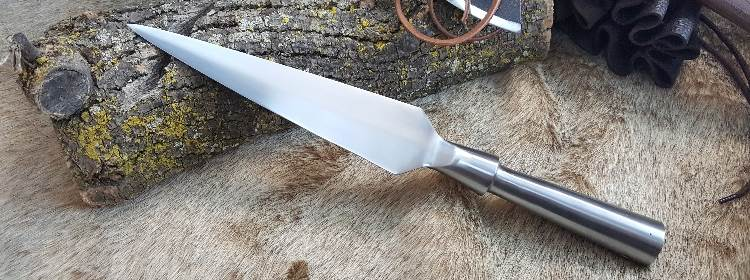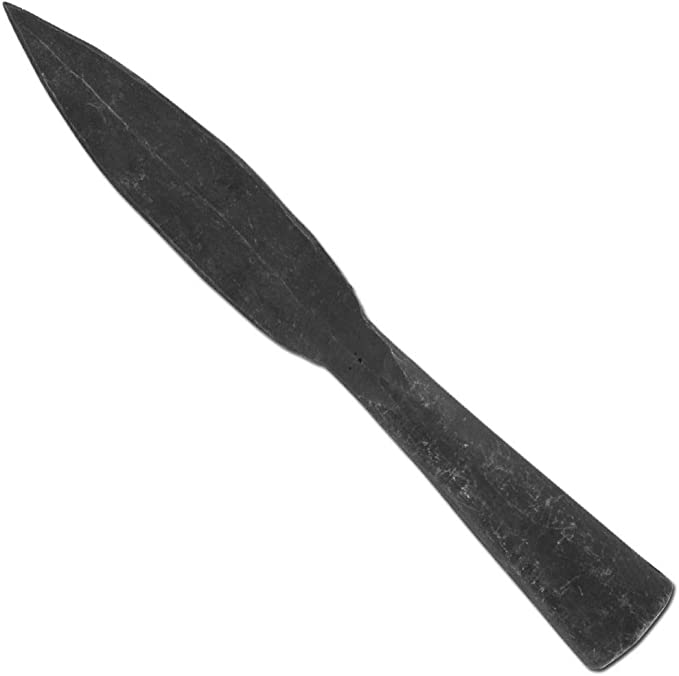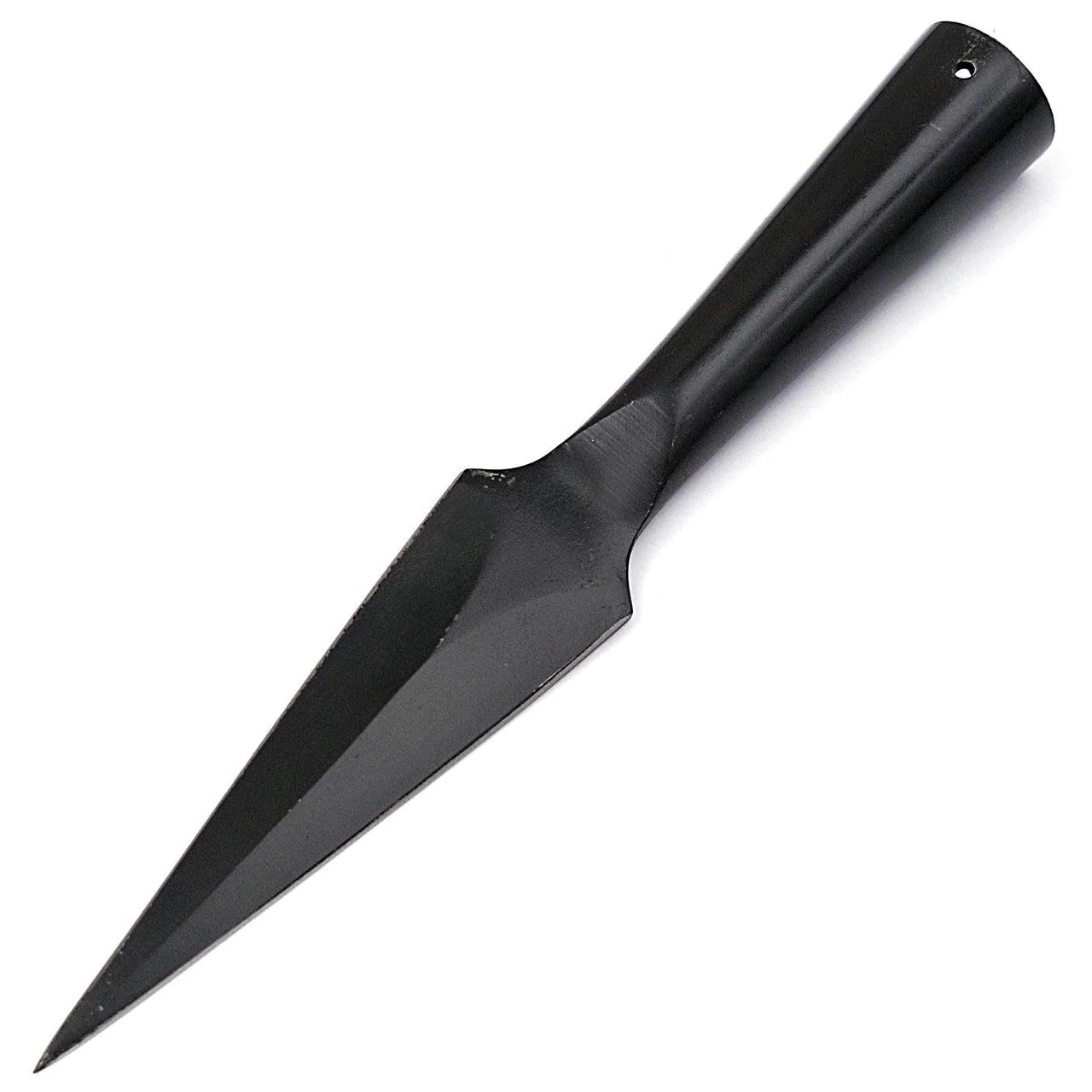Hand Forged Spear Heads
Hand Forged Spear Heads
Hand-forged spearheads have been used as weapons for thousands of years, dating back to the Bronze Age. These spearheads were made by skilled blacksmiths who used traditional techniques to shape and harden the metal.
The process of forging a spearhead involves heating the metal to a high temperature and then hammering it into the desired shape. This process not only shapes the metal but also strengthens it by aligning the grain structure of the metal. Once the spearhead is forged into shape, it is cooled slowly to harden the metal.
Hand-forged spearheads are highly prized for their durability and strength. They are often made from high-carbon steel, which is known for its toughness and ability to hold a sharp edge. The design of the spearhead can vary greatly depending on its intended use, but some common features include a pointed tip for piercing and a blade edge for cutting.
In addition to their practical use as weapons, hand-forged spearheads are also appreciated for their aesthetic value. The craftsmanship and attention to detail required to create a high-quality spearhead make it a work of art in its own right. Today, hand-forged spearheads are still made by skilled blacksmiths using traditional techniques, although they are mostly used for ornamental purposes or for reenactments of historical battles.
Hand-forged spearheads have been used by many different cultures throughout history, from the ancient Greeks and Romans to the Vikings and medieval knights. Spears were often the weapon of choice for massed formations of soldiers, as they allowed a group of fighters to attack from a distance while keeping their enemies at bay.
One of the advantages of hand-forged spearheads was their versatility. Many spearheads could be used for both thrusting and cutting, making them ideal for both offense and defense. Additionally, spears could be made in a variety of sizes, ranging from short javelins to longer pikes, depending on the situation.
Another advantage of hand-forged spearheads was their durability. Because they were made from high-quality steel and were designed to withstand the rigors of combat, they could be used for many years before needing to be replaced.
Today, hand-forged spearheads are still prized by collectors and enthusiasts. Many people enjoy collecting antique spearheads or replicas of historical designs, while others enjoy using hand-forged spears in historical reenactments or martial arts training.
Overall, hand-forged spearheads are a testament to the skill and ingenuity of ancient blacksmiths. Despite the advances in weapons technology over the centuries, the simple spear remains a powerful and effective tool for physical combat.
Introduction:
Hand forged spearheads have been in use since ancient times, and they continue to be popular among outdoor enthusiasts and collectors today. The process of forging a spearhead involves heating metal and shaping it into a pointed, blade-like form. This article will explore the history of hand-forged spearheads, their modern uses, and the different techniques and materials used in their production.
The History of Hand-Forged Spearheads:
The earliest spearheads were fashioned from stone or bone and date back to prehistoric times. As human civilizations developed metallurgy, bronze and iron spearheads replaced stone and bone. Hand-forged spearheads were an important weapon, and many ancient battles were fought with spears as the primary weapon. Greek hoplites and Roman legionnaires used spears as their primary weapon in battle.
The Modern Uses of Hand-Forged Spearheads:
Today, hand-forged spearheads are used for a variety of purposes. Some outdoor enthusiasts use them for hunting and fishing, while others use them for camping or as decorative pieces. Collectors also seek out hand-forged spearheads for their historical or cultural significance. Martial artists may also use hand-forged spearheads in training or competition.

Materials Used in Hand-Forged Spearheads:
Hand-forged spearheads can be made from a variety of materials, including steel, bronze, copper, and iron. Some spearheads are made from high-carbon steel, which is known for its durability and strength. Other materials may be used depending on the specific design and function of the spearhead.
The Importance of Heat Treating in Spearhead Production:
Heat treating is a crucial step in the production of hand-forged spearheads. It involves heating the metal to a specific temperature and then rapidly cooling it to increase its strength and durability. Without proper heat treating, a spearhead may be brittle and susceptible to breaking.
The Traditional Technique of Forging Spearheads:
The traditional technique of forging spearheads involves heating metal to a high temperature and then shaping it with a hammer and anvil. The shape of the anvil determines the shape of the final product. This technique requires skilled craftsmen and can take several hours to complete.
The Modern Technique of Forging Spearheads:
Modern techniques for forging spearheads may involve the use of power hammers, presses, or hydraulic forging machines. These machines can shape metal more quickly and with greater accuracy than traditional methods. However, skilled craftsmanship is still required to produce high-quality spearheads.
Different Types of Spearheads:
There are many different types of spearheads, each with its own unique design and function. Some common types include leaf-shaped spearheads, socketed spearheads, and barbed spearheads. The specific type of spearhead used will depend on the intended use and cultural or historical context.

Leaf-Shaped Spearheads:
Leaf-shaped spearheads are among the most common types of spearheads. They are named for their shape, which resembles a leaf or a spearhead-shaped blade. Leaf-shaped spearheads were used by ancient Greeks, Romans, and other civilizations throughout history.
Socketed Spearheads:
Socketed spearheads are characterized by a socket or sleeve at the base of the spear that fits onto a shaft. This type of spearhead has been in use since the Bronze Age and was commonly used in ancient Greece and Rome.
Barbed Spearheads:
Barbed spearheads have additional points or prongs that extend from the main blade. This design was intended to cause additional damage to a target and prevent the spear from being easily removed. Barbed spearheads were commonly used in many cultures throughout history, including the Maori of New Zealand and the Aztecs of Central America.
Decorative Spearheads:
Decorative spearheads are often created as display pieces rather than for practical use. These spearheads may feature intricate designs or be made from precious metals, and are often highly valued by collectors.
Collecting Hand-Forged Spearheads:
Collecting hand-forged spearheads can be a rewarding hobby for those interested in history and metalworking. Collectors may seek out specific types of spearheads or those from particular cultures or time periods. It is important to purchase spearheads from reputable sources to ensure authenticity.
Crafting a Hand-Forged Spearhead:
Crafting a hand-forged spearhead requires several steps, beginning with the selection of the metal to be used. High-carbon steel is a popular choice for its strength and durability. The metal is heated in a forge to its critical temperature, which varies depending on the alloy being used. Once the metal has been heated, it is shaped using a hammer and anvil or modern equipment such as a power hammer or hydraulic press. The final shape of the spearhead is achieved by grinding and polishing the metal.

Heat Treatment of a Hand-Forged Spearhead:
Heat treatment is a crucial step in the production of hand-forged spearheads. The purpose of heat treatment is to increase the strength and durability of the metal. The metal is heated to a specific temperature and then rapidly cooled by quenching in oil or water. This process causes the metal to become harder and more resistant to bending or breaking.
Sharpening a Hand-Forged Spearhead:
Sharpening a hand-forged spearhead requires the use of a sharpening stone or grinder. The blade should be sharpened to a fine edge to ensure optimal cutting ability. The sharpening process should be done carefully to avoid damaging the metal or weakening the blade.
Maintaining a Hand-Forged Spearhead:
Proper maintenance of a hand-forged spearhead is important to prevent rust or damage to the blade. After use, the spearhead should be cleaned and dried thoroughly. Any signs of rust should be addressed immediately using a rust removing solution. To prevent rust, the blade can be coated with a thin layer of oil or wax.
Using a Hand-Forged Spearhead:
Using a hand-forged spearhead requires skill and practice. The spear should be held with both hands, with the non-dominant hand near the base of the spear and the dominant hand near the head. The spear should be aimed at the target and thrust forward using the body's momentum for maximum force.
Historical Use of Hand-Forged Spearheads:
Hand-forged viking spears have played a significant role in many historical events. In ancient Greece, the hoplite warrior used a spear as his primary weapon in battle. The Roman legionnaire also used a spear as his primary weapon. The Norse Vikings used a spear called the seax as a weapon and tool. The Maori of New Zealand used a barbed spearhead called a taiaha as a symbol of power and for ceremonial purposes.
Cultural Significance of Hand-Forged Spearheads:
Hand-forged spearheads have significant cultural meaning in many societies. The Zulu of South Africa use the Iklwa spear in their traditional dances and ceremonies. The spear is considered a symbol of leadership and strength. The Native American tribes also used spears for hunting and in their rituals and ceremonies.
Contemporary Use of Hand-Forged Spearheads:
Hand-forged spearheads are used today for a variety of purposes. Outdoor enthusiasts may use them for hunting or fishing. Some martial arts practitioners use spearheads for training and competition. Collectors may seek out authentic hand-forged spearheads for their historical or cultural significance.
The Art of Hand-Forged Spearhead Making:
The art of hand-forged spearhead making requires skill and experience. There are many master craftsmen who specialize in creating high-quality hand-forged spearheads. These craftsmen follow a process that has been refined over centuries, using traditional techniques and modern technology to produce intricate and durable spearheads.
The Value of Hand-Forged Spearheads:
Hand-forged spearheads can vary greatly in value depending on their historical or cultural significance, rarity, and craftsmanship. High-quality hand-forged spearheads can command high prices at auction or through private sales.
Finding Hand-Forged Spearheads to Purchase:
Hand-forged spearheads can be purchased from a variety of sources, including antique dealers, collectible shops, and online marketplaces. It is important to purchase from reputable sources to ensure the authenticity and quality of the spearhead.
The Future of Hand-Forged Spearheads:
Hand-forged spearheads have a rich history and continue to be used for a variety of purposes today. With advancements in technology and changes in society, the future of hand-forged spearheads may change. However, the art of hand-forging metal remains an integral part of human history and is likely to continue for centuries to come.
Appreciating the Craftsmanship of Hand-Forged Spearheads:
Hand-forged spearheads are not only functional weapons but also works of art. The craftsmanship and attention to detail required to produce high-quality spearheads are impressive and deserves to be appreciated. Collectors and enthusiasts can appreciate the skill and tradition behind the creation of hand-forged spearheads.
Conclusion:
Hand-forged spearheads have a rich history and continue to be used for a variety of purposes today. From ancient weapons to decorative art pieces, the hand-forging of metal has been a vital part of human history. The process of creating hand-forged spearheads requires skilled craftsmanship and knowledge of metallurgy. Collectors and enthusiasts can appreciate the beauty and quality of hand-forged spearheads, and the tradition of hand-forging metal is likely to continue for generations to come.
The Importance of Hand-Forged Spearheads in Survival Situations:
Hand-forged spearheads can be a vital tool for survival situations, especially in the wilderness. With its sharp point and sturdy construction, a spearhead can be used for self-defense, hunting, and in building shelters. It is a versatile tool that can help in various situations.
The Role of Hand-Forged Spearheads in Hunting:
Hand-forged spearheads have been used for hunting since ancient times. The pointed end of the spear is perfectly designed for piercing through animal hide, making it an effective tool for hunting large game. This method of hunting is still utilized in some remote areas of the world.
Hand-Forged Spearheads in Martial Arts:
Hand-forged spearheads are sometimes used in various martial arts practices. The technique of using a spearhead requires skill and is typically taught by experts in the field.
The Symbolism of Hand-Forged Spearheads:
In some cultures, hand-forged spearheads can have symbolic meanings. For example, in the Samoan culture, the Nifo Oti spearhead is a traditional weapon and symbol of male leadership. In some other cultures, hand-forged spears are viewed as a symbol of strength and power.
Hand-Forged Spearheads as Artifacts:
Many hand-forged spearheads are considered valuable artifacts that provide valuable insights into the history and culture of ancient civilizations. These spearheads allow us to learn about the techniques and materials used by people in the past, as well as the symbolism and significance these items held.
The Different Styles of Hand-Forged Spearheads:
Hand-forged spearheads come in a variety of styles, each with its unique design and shape. Some of the most common styles include the barbed spearhead, the leaf-shaped spearhead, and the socketed spearhead.
The Role of Hand-Forged Spearheads in Mythology:
Hand-forged spearheads have a prominent role in mythology, often representing a symbol of power or strength. In Greek mythology, the spear was the weapon of choice for the god of war, Ares. In Norse mythology, the warrior god Odin is depicted carrying a magical spear called Gungnir.
The Importance of Craftsmanship in Hand-Forged Spearheads:
viking spear require skilled craftsmanship, and those who forge these weapons are highly skilled in the craft. The level of expertise required to shape and heat the metal and produce a durable and functional spearhead is a testament to the skill and dedication of the craftsman.
Hand-Forged Spearheads in Warfare:
Hand-forged spearheads have been used in warfare for centuries. The spear was a weapon that was easy to produce and could be used effectively in large numbers. Various civilizations throughout history have used spears in large-scale battles.
The Evolution of Hand-Forged Spearheads:
viking spear have evolved over time, with changes in materials, designs, and manufacturing techniques. Modern-day hand-forged spearheads display both traditional and modern design elements, allowing for a wider range of uses.
The Role of Women in Hand-Forged Spearhead Craftsmanship:
In some cultures, women have played a significant role in hand-forged spearhead craftsmanship. For example, the Hamauchu culture of the Brazilian Amazon is known for its distinctive barbed spearhead, which is traditionally made by women.
Hand-Forged Spearheads in Fishing:
Hand-forged spearheads can be an effective tool for fishing, especially in shallow water areas. They can be used to catch fish by skewering them, making them a useful tool in survival situations.
Preservation of Hand-Forged Spearheads:
Preservation of hand-forged spearheads is essential to ensure their historical and cultural significance is not lost. Organizations and museums around the world work to preserve hand-forged spearheads, ensuring they remain accessible to future generations.
The Future of Hand-Forged Spearheads in Art and Design:
Hand-forged spearheads continue to play a vital role in the world of art and design. Many modern-day artisans incorporate hand-forged spearheads into their designs, creating unique and functional pieces that showcase the beauty and skill of the craft.
Conclusion:
Hand-forged spearheads have played an essential role throughout human history, serving as weapons, tools, and symbols of power and strength. These spearheads require skilled craftsmanship, utilizing traditional techniques and modern technologies, to produce intricate and durable designs. They continue to play a crucial role in various aspects of modern society, including survival situations, hunting, martial arts, and art and design. The preservation and appreciation of hand-forged spearheads is vital to ensure that their historical and cultural significance is not lost.
Conclusion:
Hand-forged spearheads have a rich history and continue to be used for a variety of purposes today. The process of forging a spearhead requires skilled craftsmanship and knowledge of metallurgy. Different types of spearheads have been used throughout history, each with its own unique design and function. Collecting hand-forged spearheads can be a rewarding hobby for those interested in history, culture, and metalworking.
